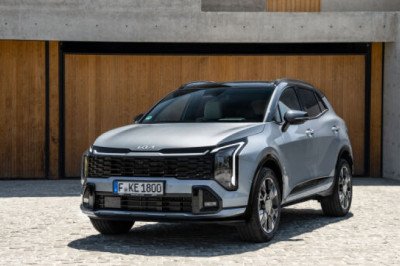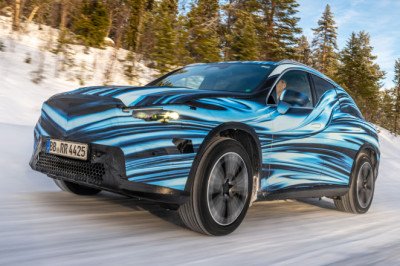
Whether it’s the supple way it seems to contour to your body, the fragrant scent it emits, or perhaps the way it ages gracefully, leather has long been the dominant high-end upholstery choice.
If you need convincing, just look at the sheer number of synthetic leather options currently available; nearly every auto manufacturer offers a leather facsimile as an option. And some, like Toyota and Lexus, make synthetic leather mandatory on many top-selling models like the Toyota RAV4 and Lexus NX.
But leather, if we’re honest with ourselves, is not a great upholstery choice. For one, it is animal-derived, and it takes a tremendous amount of effort to defend the way it is sourced. Then there’s the tanning process, which generally involves toxic chemicals and results in a tremendous amount of water waste. Lastly, leather is hot to the touch in summer and downright frigid in winter. Only on the most perfect of days does leather seem to coddle in the way we want it to.
Objectively, fabric is a far better upholstery. For the same reasons most of us don’t wear leather pants, we routinely choose fabric for our living rooms and desk chairs. It breathes well, can be made in numerous different styles, and is never particularly hot or cold.
Once upon a time, fabric was commonly used in high-end vehicles. It shows occasional signs of a resurgence, though whether it will ever make a complete mainstream comeback remains to be seen.
Early chauffeur-driven vehicles had sumptuous, plush, enclosed seats covered in fabric, which also adorned the door and side panels. These vehicles were a vestige of coupé horse carriages, where the driver sat outside and could easily control the equine motivation. The driver’s bench was a simple leather affair—usually black—which resisted its exposure to the elements.
The fabric-upholstered seats inside the vehicle’s cabin were often stuffed with horsehair or cotton and usually had a metal spring construction. In terms of their basic design and construction, they differed little from the kind of furniture Europeans—and, subsequently, Americans—began placing in their homes before the Industrial Revolution. A fine fabric was generally a sign of wealth. Even today, you’ll generally find fabric in elegant settings like Broadway theaters.
Cars meant to be driven by their owners lacked any sort of partition between the driver’s space and that of occupants in the rear. Those with folding or removable tops typically had leather upholstery for durability, while enclosed vehicles of all price points used varying levels of fabric trim roughly up until the postwar era. Just why fabric began to fall out of favor is anyone’s guess. Certainly, high-end brands generally shifted toward leather as the upholstery of choice, regardless of body style—at least for American and European vehicles.
Synthetic leather was virtually unheard of as an upholstery option until after World War II, when Mercedes-Benz made its MB-Tex vinyl a near-household name. The artificial material was, at least initially, intended to be ersatz leather developed for use during wartime restrictions in Germany. A version called Presstoff was used for a variety of military and civilian needs where leather had been more common.
Eighty years on, synthetic leather now generally has a polyurethane coating that gives it a suppleness that closely approximates the real McCoy. The best part? It requires virtually no maintenance to look practically new. If anything, these synthetic leather materials marketed under such monikers as SynTex (Kia), StarTex (Subaru), Nordico (Volvo), and Inteluxe (Cadillac) may very well be accelerating fabric’s demise as a mainstream option—but more on that in a moment.
Ask anyone who’s been to Japan: it is a markedly different place than anywhere else in the world. Despite its inevitable hustle and bustle, Tokyo, the country’s capital and flagship city, has a certain relaxed charm. Toyota taxi cabs don’t thunder down its streets; they seem to glide over special pavement designed to make as little rumble as possible. It’s hard not to feel relaxed in Japan.
For many years, the country’s cars imparted a similarly hushed aura. In a 1990 Car and Driver comparison against a Bentley Turbo R, a V-12-powered BMW 750iL, and a Mercedes-Benz 560SEL, the inaugural Lexus LS 400 was noted for its silky engine, its quiet driveline, and its placid demeanor. Japan’s first export-market-focused luxury car was more refined than luxury cars costing three times as much. It also came standard with cloth seats, something essentially unheard of in luxury rivals. Sure, Cadillac and Lincoln came standard with cloth, but that upholstery option undoubtedly existed so that dealers could advertise a low price point in the newspaper classifieds section. The only way to get cloth seats in a high-end BMW or Mercedes-Benz in 1990 was to get one outside the U.S. We were that entrenched in the idea that leather, or at least something approximating it, equated to upscale.
In Japan, it was the opposite story. The generally accepted rationale for Japan’s aversion to leather in the 1980s and 1990s had nothing to do with ethical procurement or how it felt on hot or cold days. Instead, it was the idea that leather seats squeaked and squealed as occupants slid across them. (Presumably, this noise was much worse when wearing the aforementioned leather pants, though the author has no plans to test this theory.)
As a result, high-end Japanese Domestic Market (JDM) cars like the Toyota Celsior (our Lexus LS) and the Toyota Century (a retro-style, ultra-plush car favored by CEOs) were generally fitted with fabric seats for the Japanese market. Even the latest version of the Century, which went out of production just a few years ago, came draped in a mouse fur-like fabric upholstery.
By the early 2000s, cloth largely vanished as an option on luxury vehicles. Sure, there were some notable exceptions like the festive, bus-like pattern in the 1998 Mercedes-Benz ML320, but synthetic and real leather soon became the default. The trend even made its way to non-luxury brands; today, many trim levels of Kia and Toyota models, in particular, offer cloth only in their cheapest configurations. You’ll get synthetic or real leather if you start stepping up the trim ladder.
There are some notable exceptions, though it’s not clear if fabric will ever take over again. Volvo is arguably the most notable. It periodically offers textile trim made out of either recycled plastic or, in its costliest models, a wool blend. Land Rover has also dabbled with wool, which seems appropriate given just how common sheep are in England.
Some other automakers use retro-style cloth for special models. Porsche’s modern version of its classic Pepita houndstooth print makes an occasional comeback, and the automaker has dabbled in neo-plaid upholstery as well. While certainly limited in scope, the aftermarket industry has also responded to demand for cloth upholstery. Companies like Dallas-based P1 Designs offer bespoke, often heritage-inspired cloth inserts for certain modern Porsche models.
It may not be a true luxury model, but the 2024 Toyota Land Cruiser’s retro-esque 1958 trim level (which marks the model’s first year in the U.S.) has cloth seats somewhat inspired by early-1990s Land Cruisers. To be fair, that upholstery is part of a downward push by Toyota to give more breathing room to the (cloth-free) Lexus LX. Most recently, Mercedes-Benz dug into its archives for a modern version of the plaid it long offered in its Austria-built G-Wagens. Its new-for-2025 “Stronger than the 1980s” (yes, that’s its real name…) G-Wagen comes with bold plaid inserts.
As for domestic brands, cloth has been absent from Cadillac and Lincoln models for decades, and even in the 1990s, it was basically treated as a special-order item on models like the Lincoln Town Car and Cadillac SLS.
The common denominator with all of these more modern cloth offerings is that they’re a quirky option and not a mainstream choice. Even the Toyota Century does so because the model is steeped in tradition, which in the Toyota lineup makes the latest version something of a novelty.
VW’s GTI plaid cloth deserves a mention as well.















Facebook Conversations